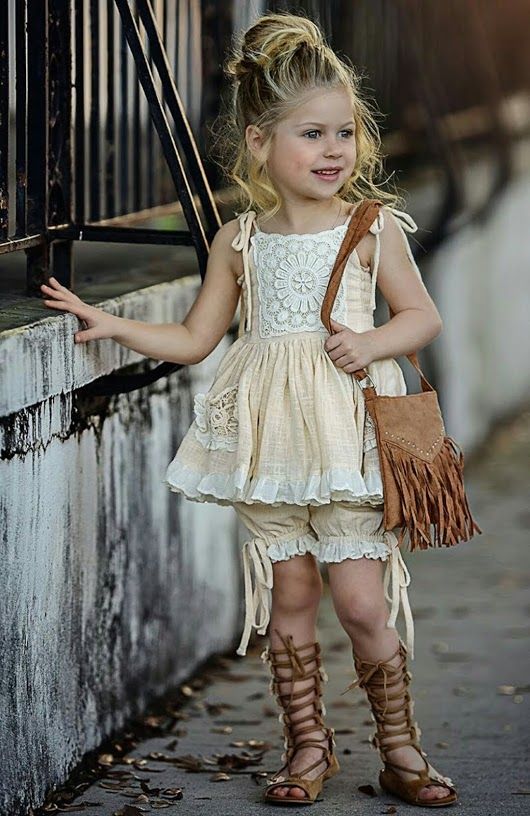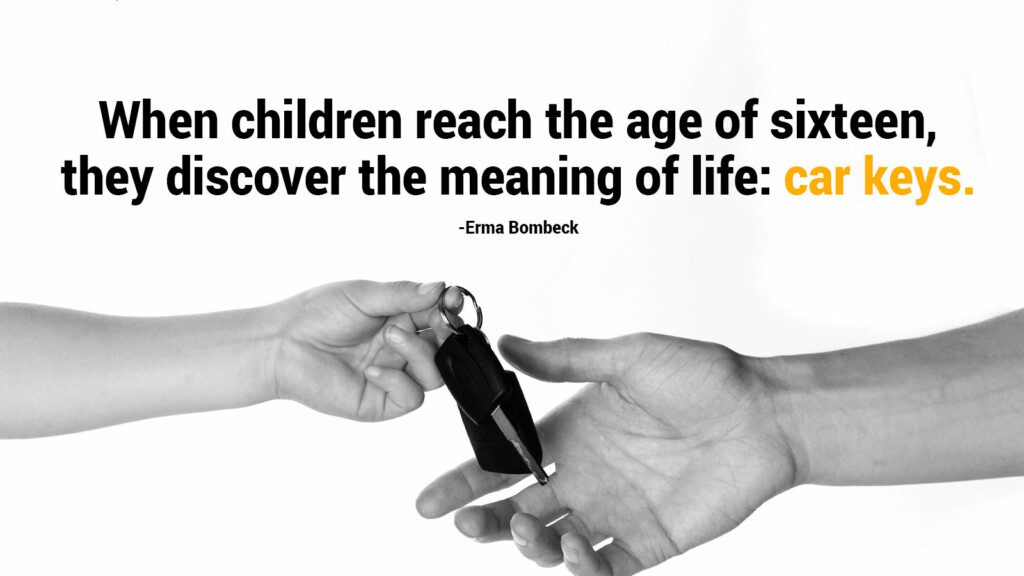How to teach your child ride a bike
How to Teach a Kid to Ride a Bike
Wondering how to teach your kid to ride a bike? Whether your child is brand new to a bike, is ready to get off of training wheels, or is struggling to transition from a balance bike to a pedal bike, there’s a simple and stress-free method to teach your child to ride! It doesn’t involve training wheels, and it doesn’t involve you running behind them while you hold onto the bike’s saddle!
Some kids need help with the whole process, while others (usually balance bike graduates) simply need help understanding how to pedal forward. These are two different problems with two different solutions!
Which Scenario Describes You?
(Click the “Problem” below to skip forward)
PROBLEM 1: My child can’t ride a bike at all and I need help!
PROBLEM 2: My child can balance on a bike, but just can’t pedal forward.
Teaching Your Kid to Ride a Bike Can Be Easy!
If your child is new to a bike, you can get your child off and riding in no time. Here’s the secret – simply take the pedals off of your child’s bike and use it as a balance bike!
This simple method allows a child to focus on learning to balance on two wheels, which is the most important skill in learning to ride. A child can learn to pedal later… BALANCE FIRST!
As a result, the fastest, easiest, and most effective way to teach your child to ride a bike is simply by taking the pedals off their bike so they can focus on balancing, rather than pedaling.
This “take the pedals off” method works best for 16″ bikes and larger, but can also be used on smaller bikes. If your child is currently on a 12″ or 14″ pedal bike, considering buying a balance bike instead (there are many great balance bike options under $100), but this method works great as well.
Getting Started – Suggestions for Success
While using a pedal bike as a balance bike is a simple method, there are a few key things to know before you dive in. Here are four pieces of advice that will ensure a smooth and happy process.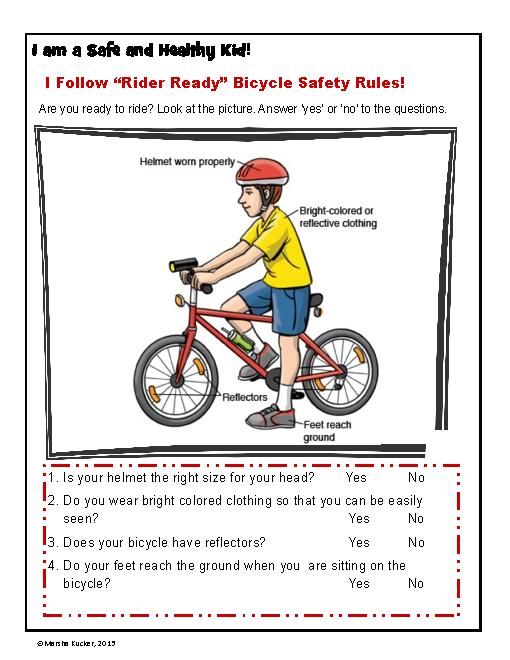
- FEET FLAT: A child should be able to touch the ground with their feet flat while sitting on the saddle. This will allow them to push off the ground to gain momentum, and also stop and start the bike independently and safely.
- LOW SADDLE: If a child can only reach the ground with their tip toes, this method will be harder for them. If the saddle isn’t low enough, you can try removing the rear reflector from the seat post.
- LIGHTWEIGHT: This method is much easier if the bike is lightweight. True balance bikes are usually under 10 pounds. Heavier pedal bikes make learning to balance more difficult. If your child’s bike is heavy, you many want to try to borrow a lighter bike from a friend.
- PATIENCE!: Your child’s success and how long it will take them to master a pedal bike is highly dependent on their athletic ability, determination, and confidence when trying new things. This method could take less than 10 minutes for a confident, athletic child, while it could take a timid child weeks or even months.
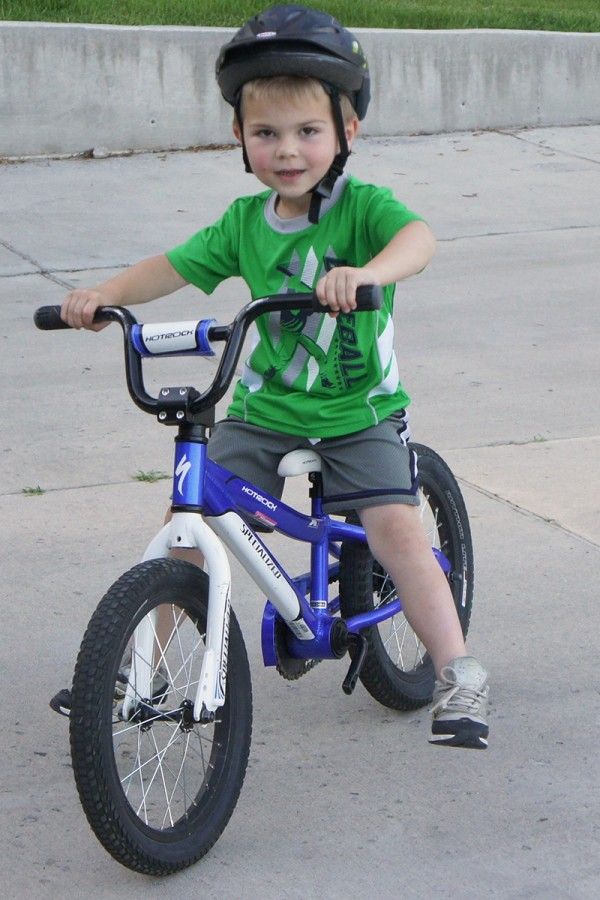
How to Turn a Bike into a Temporary Balance Bike
Let’s get those pedals off and outline how to instruct your child to use their new “balance bike”!
STEP 1: Remove the Pedals
While this step isn’t absolutely required, it will make the learning process a whole lot easier for your child. Using a wrench, you’ll remove both the pedals from the crank arms of your child’s bike.
Here are a few important things to note:
- The left and right pedals are threaded in opposite directions. The right pedal is threaded normally – turn counterclockwise to loosen. The left pedal is threaded in reverse – turn clockwise to loosen
- Using a piece of tape, mark the pedals with an L and R so that you know which is which when you need to put them back on. (Left is left foot, right is right foot.)
- If you forget, there may be an L or a R somewhere on the pedal. If not, the left pedal usually has some sort of marking on it – a line on the spindle or other markings.
 The left pedal below is both marked “left” and has lines on the spindle.
The left pedal below is both marked “left” and has lines on the spindle.
STEP 2: Leave the Crank Arms
While in a perfect world you would also remove the crank arms, this is a difficult and sometimes an impossible process. We’ve found that removing just the pedals works fine and the crank arms generally don’t get in the way of your child’s legs while they are learning to ride a bike.
Be aware that if you have a cheaper bike, the distance between the pedals may be very wide. This means that your child would have more difficulty using it as a balance bike because their legs will be spread wider than is natural to walk or run. Depending on how wide the bike is, the crank arms of the bike could possibly hit their legs.
Narrow Kids Bike vs. Wide Kids Bike
STEP 3: Set the Seat Height Properly
The bike’s seat should be set so a child’s feet can be flat on the ground when sitting on the saddle, ideally with a slight knee bend (if the seat can go that low).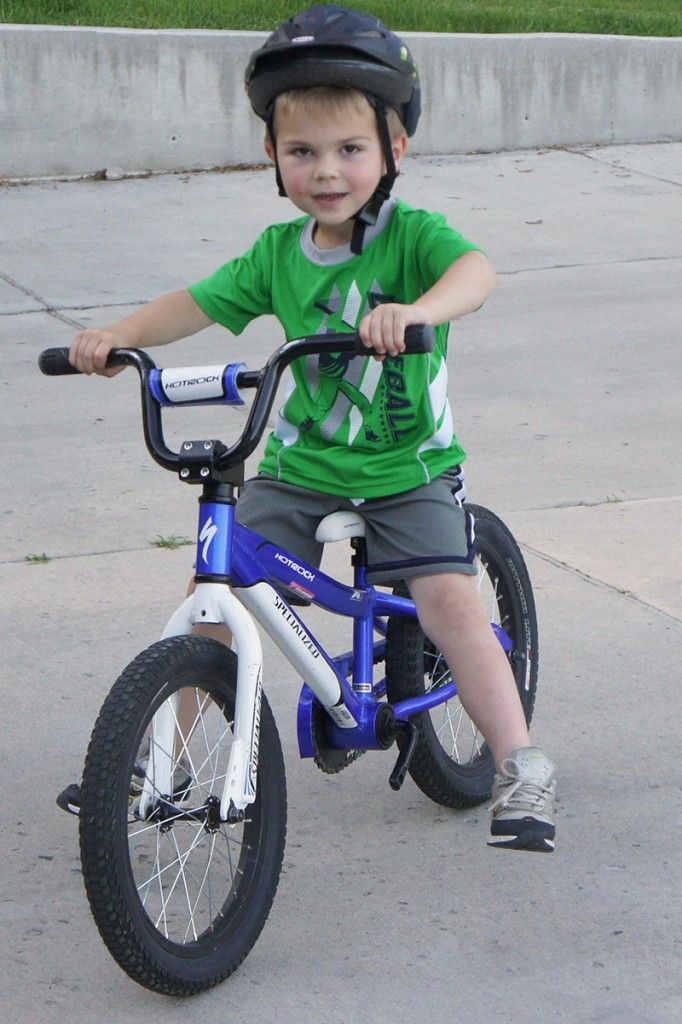 If this isn’t possible, remove the rear reflector to set the seat as low as possible.
If this isn’t possible, remove the rear reflector to set the seat as low as possible.
STEP 4: Sit and Walk
How to teach a child to ride a bike really starts here! Have your child sit on the seat with all of their weight, and use their feet to walk the bike forward.
Remember that through the whole process of learning to ride a bike, your child should be wearing a bike helmet.
STEP 5: Sit, Run, and Glide
Once the child is comfortable walking slowly on the bike, have them try to run and then eventually glide and balance. If they are struggling with this idea, give them a little help with their momentum.
How? Rolling down driveways or grassy hills is a great way for them to easily pick up speed and learn the feel of gliding and balancing.
Once they’ve mastered going in a straight line, your child will need to learn to balance and steer. Have your child work on turns while gliding. They could roll down the hill and then do a slight turn to either side.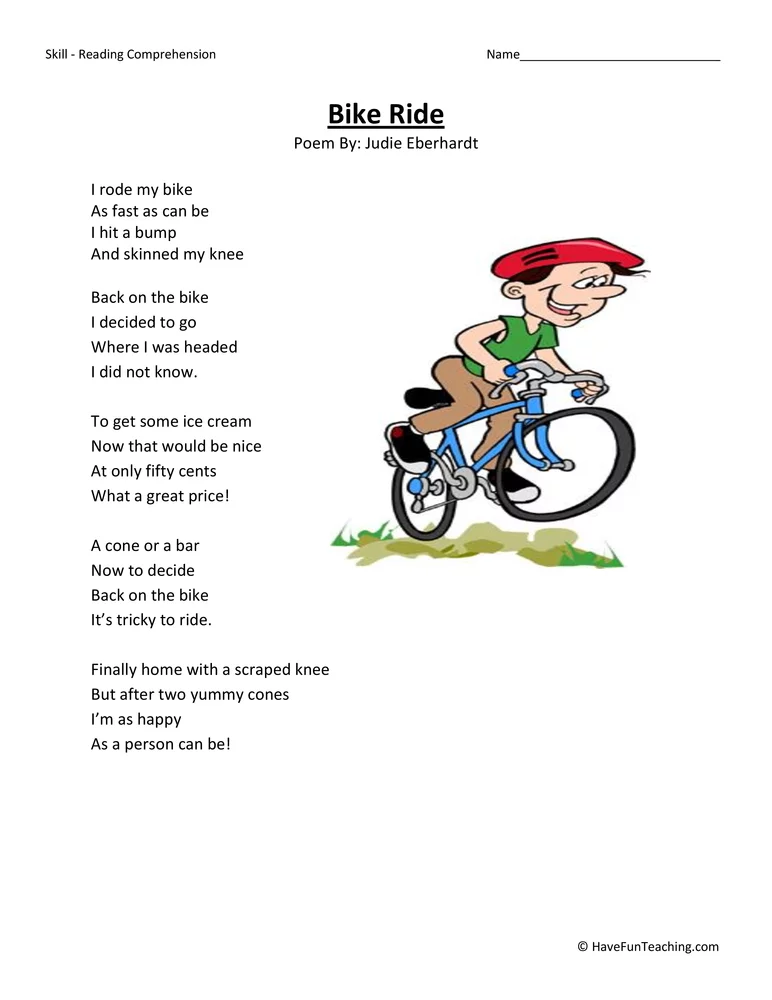 Learning the feel of how the handlebars react and how to steer the bike when turning during a glide is essential. Most kids pick it up naturally, but some don’t, so make sure they practice.
Learning the feel of how the handlebars react and how to steer the bike when turning during a glide is essential. Most kids pick it up naturally, but some don’t, so make sure they practice.
Important Note: If your child’s bike has a coaster brake and no handbrakes, the only way they will be able to stop the bike at this stage is with their feet.
STEP 6: Balance Mastery – Don’t Rush the Pedals!
Remember, the entire purpose of this exercise is to teach a child to balance on a bike. Don’t pressure them to put the pedals back on before they can clearly balance while in motion for long distances, and also comfortably turn the bike while gliding.
Some kids will master this in 10 minutes, while other kids days or weeks. Exercise patience and let the child use the bike as a balance bike as long as they need to!
Turn the Bike Back Into a Pedal Bike and Ride!
When a child has mastered balancing and steering, it’s time to put the pedals back on!
STEP 1: Put the Pedals Back On
Using the same wrench as before, put the pedals back on.
- Remember that the pedals are “side specific”. Right pedal on the right foot, left pedal on the left foot.
- Right pedal – turn clockwise to tighten. Left pedal – turn counter-clockwise to tighten.
- Pedals can be tricky to get started threading, but never force them or you could strip them. There should be very little resistance to get the pedal started. In the image below, you can see the pedal that has just started threading into the crank arm.
STEP 2: Keep the Saddle Low, But Raise it a Little
After adding the pedals back onto the bike, a child still needs to be able to stop and start the bike with their feet, just like they did while it was a “balance bike”. But to allow for more efficient pedaling, you need to raise the seat height so the child can touch the ground with feet flat, but no knee bend.
Once they are very confidently pedaling, you can raise the seat height again so they can touch the ground with solid tip toes.
STEP 3: Sit and Gain Momentum
To ride the bike with pedals back on, have your child first run on the bike like they did without the pedals. They will need to place their feet behind the pedals to do this. This is usually easier on a slight decline.
They will need to place their feet behind the pedals to do this. This is usually easier on a slight decline.
STEP 4: Put Their Feet on the Pedals
Once a child has gained enough momentum, put those feet on the pedals and go!
Important Note: If your child’s bike has a coaster brake, getting the pedals into “start position” will be problematic. Additionally, many kids pedal backwards to regain their balance, especially when first learning to ride a bike. A coaster brake will cause the bike to stop when the child pedals backwards.
Having Trouble Balancing and Pedaling at the Same Time?
- If you think your child needs a little help, you can guide them with a gentle hand centered on the shoulders around the neck. Do not try to grab their bike, which will throw off the child’s balance.
- A bike is more stable at higher speeds. If a child is slowing down too much, (often due to stopping to look at their feet to figure out pedaling), give them a gentle push on their back to make sure they keep their speed up.
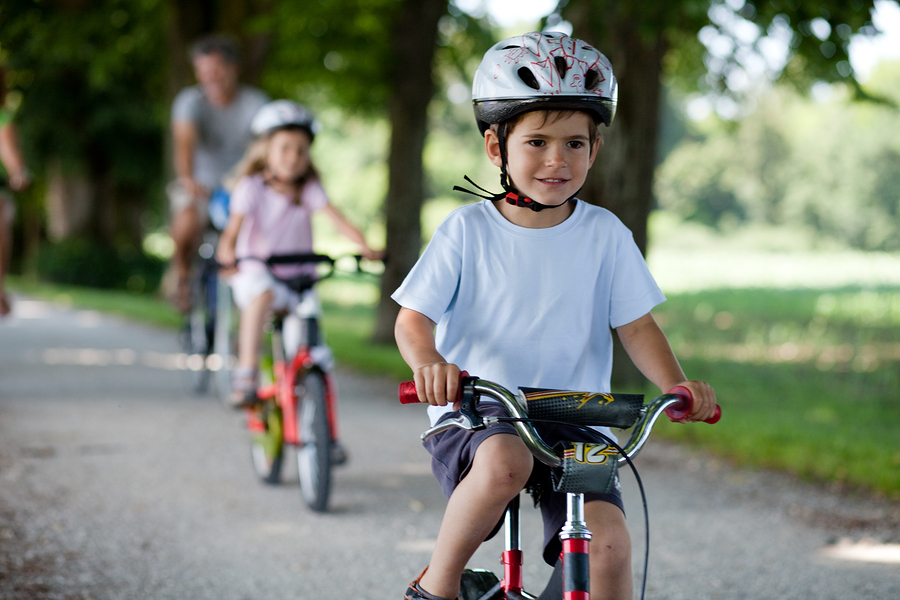
- If this doesn’t work, take the pedals back off and give your child more time on their “balance bike”. It’s okay if your child needs a little more time to learn to ride a bike. And it’s also okay if your first effort to teach your child to ride a bike wasn’t 100% successful!
How to Help a Child Who Can’t Pedal Forward
If your child can’t figure out the pedaling motion, this is normal! With most young kids, it’s actually more natural for them to pedal backward than it is forward. So while learning to pedal, it is very common for kids to get confused and pedal forward and then backward and then forward again!
Use a Trainer to Learn the Pedal Motion
To help kids master the forward motion of pedaling, we’ve found that the best way is to use or build a “bike trainer” to allow them to only work on pedaling. Without the need to worry about balancing, steering, starting, or stopping, trainers are a quick and easy way to allow kids to focus just on pedaling.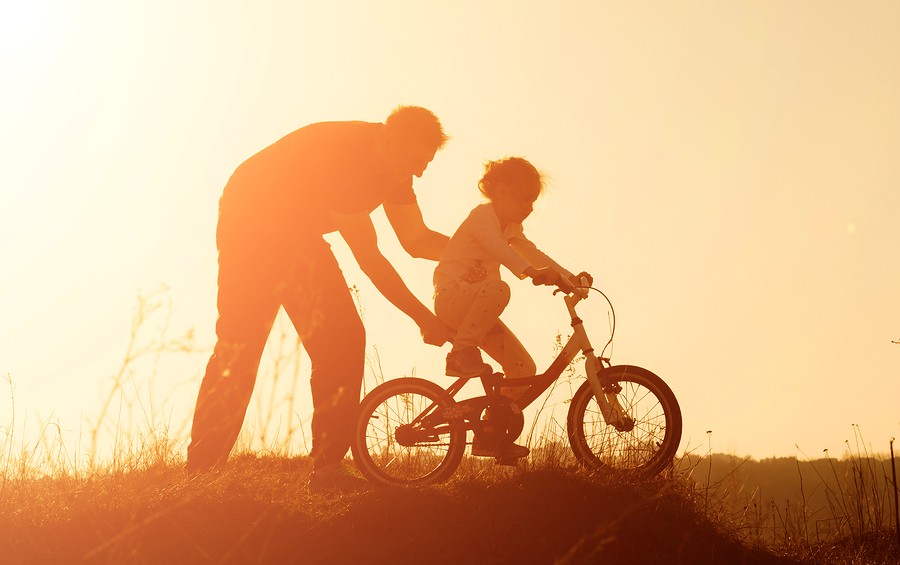
Once you’ve built your “trainer”, kids typically progress pretty quickly. By supporting the front tire (to keep the handlebars from moving) while also lifting the rear tire off the ground, the child pedals without propelling the bike forward.
Trainers are our favorite method because they allow you to stand right next to your child to coach and encourage them as they work through the motions. While some kids just need verbal reminders to push down with their legs, others benefit from an adult putting their hands on their knees to carefully help them through the correct motions.
OPTION 1: Toy Blocks Trainer
The quickest and easiest way to build a “trainer” is to use toy blocks (or other similarly shaped objects). Just stack up the blocks tall enough to prop the rear tire off the ground. This method does require an adult to support the back and the front of the bike to prevent it from falling, but it’s quick and easy and kids usually learn the motion of pedaling pretty fast.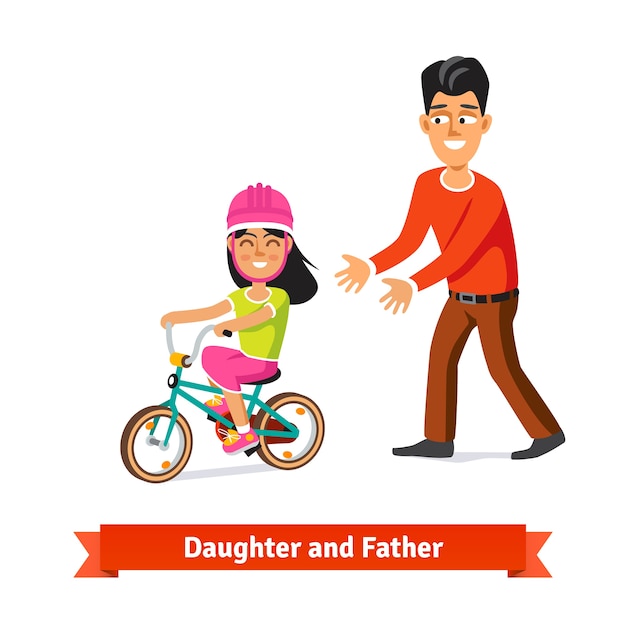 This method is also a winner because it works on any bike!
This method is also a winner because it works on any bike!
OPTION 2: Training Wheels Trainer
If your child’s bike came with training wheels, you can use them to help practice pedaling. Just set the training wheels to their lowest setting and then prop up the training wheels with bricks or a small block of wood (unless your bike’s training wheel will mount lower than the back tire – which is rare).
Like the DIY trainer, this method will require an adult to hold the handlebars and the back of the seat to keep the bike stable.
OPTION 3: Balance Buddy “Trainer”
The Balance Buddy is a handlebar for parents that attaches to the rear axle of a child’s bike. While not a true trainer (that allows kids to just work on their pedaling), the Balance Buddy does allow you to hold the child upright as they learn to pedal. If the child accidentally pedals backward (and for some bikes activates the coaster brake) the Balance Buddy allows you prevent them from falling over!
The Balance Buddy also tends to work better on larger 16″ and 20″ bikes as the larger bikes can be more difficult to hold steady on a DIY trainer. The downside of the Balance Buddy is that when the kids pedal, the bikes moves, so the adult helper needs to be able to walk or run along with them.
The downside of the Balance Buddy is that when the kids pedal, the bikes moves, so the adult helper needs to be able to walk or run along with them.
Teaching a Child to Ride a Bike is Easier than You Think!
How to teach a child to ride a bike doesn’t have to be a complicated question or a stressful solution! By following the simple steps outlined in this article, your child will learn to ride a bike – whether in 10 minutes, a week, or 2 months. Just like everything with kids, your little one will master these skills when your child is ready. So get your patience pants on. They can do it… and so can you! 🙂
10 Frequently Asked Questions About Training Wheels
Fool proof method to teach your kid to ride a bike
Customer service is important to us!
Takoma Bicycle Home News Fool proof method to teach your kid to ride a bike
Jun, 23
Back in the day, the running-along-side method was the go-to technique to teach your kid to ride a bike.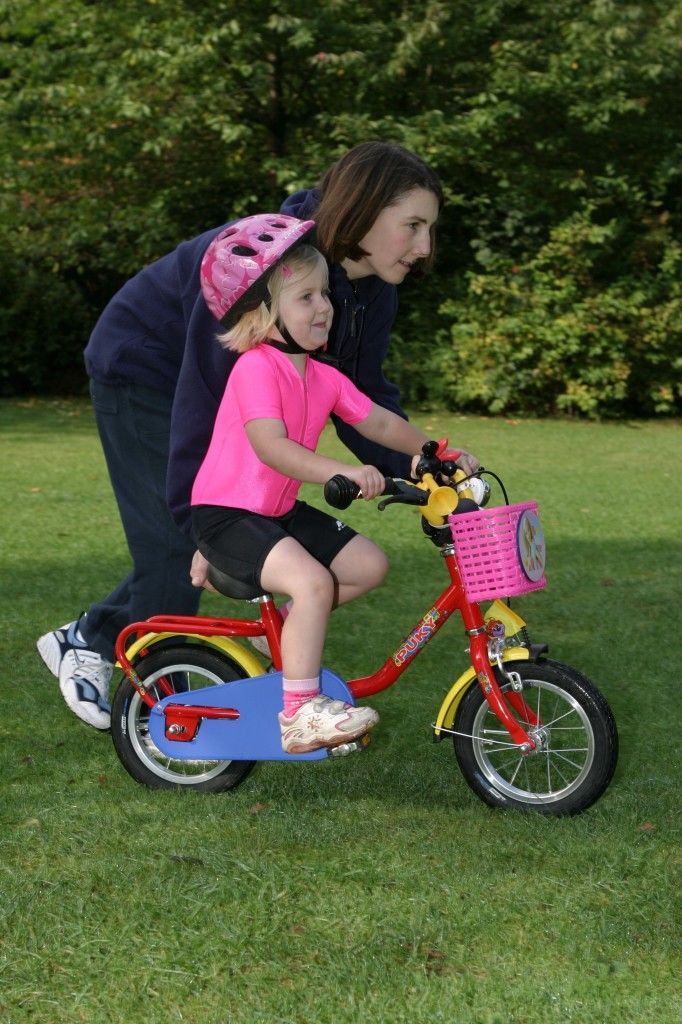 It's probably how you learned. It still works. But one big thing to keep in mind–DO NOT tell your kid you're not going to let go and then let go. If they crash, you break their trust and their confidence. However, there’s a newer method on the block. This method teaches kids to master a few different skills at a time, so they aren't overwhelmed. It might help you from going crazy too. Of course, there's going to be a few bumps and bruises along the way, so have plenty of fun cartoon Band-Aids on hand. The boring beige ones just won't cut it.
It's probably how you learned. It still works. But one big thing to keep in mind–DO NOT tell your kid you're not going to let go and then let go. If they crash, you break their trust and their confidence. However, there’s a newer method on the block. This method teaches kids to master a few different skills at a time, so they aren't overwhelmed. It might help you from going crazy too. Of course, there's going to be a few bumps and bruises along the way, so have plenty of fun cartoon Band-Aids on hand. The boring beige ones just won't cut it.
- Don't make the day you actually bring home the bike, or as we like to call it 'Bike Day,' the same day you take the training wheels off. Let your little one tool around the block for a few weeks on training wheels, or until he or she feels comfortable enough to take the plunge.
- OK, it's the big day. Remove the training wheels. Then, lower the saddle so it's low enough for your child to place their feet flat on the ground when sitting on their bike.
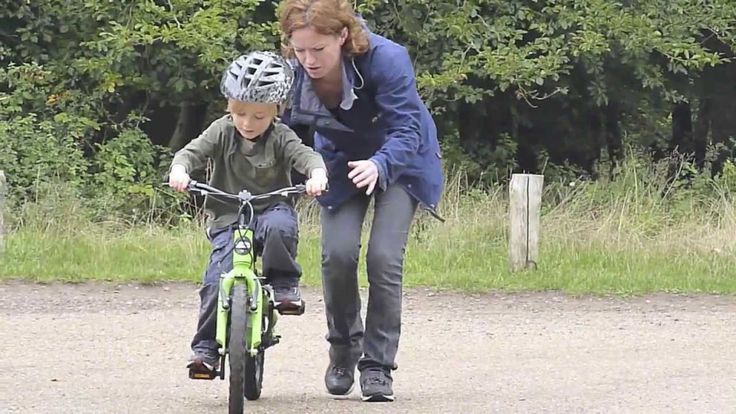
- Grassy field, here we come. Find a soft slope of about 30 yards. Ideally, the slope turns into a slight uphill or flattens out to slow things down. We're also looking for grass that's long enough to cushion a fall but short enough to keep things moving. (Yes, there are a lot of 'ideals' here, but just do your best to find a good spot.)
- Safety first. Always, always, always strap on a helmet. And make sure all shoelaces are tucked in.
- We're going to tackle balance first–we'll deal with pedaling next. Start halfway up the hill and hold the bike while your child climbs on. Now, let go of the bike and have your child lift their feet so they coast down the hill. Again, we're working on balance, so no pedaling. Avoid holding onto the bike. Instead, tell them to put their foot down when they feel unbalanced.
- Keep working on coasting 'til they are comfortable–make it a fun game and count the seconds 'til they put their foot down.
 There's no need to rush to the next step. You might be here for a few days or weeks.
There's no need to rush to the next step. You might be here for a few days or weeks. - OK, it's time to put the pedal to the metal. This time, have your child just place their feet on the pedals and coast. Try a few runs, just coasting, and then have them start to pedal.
- Once they feel comfortable, raise the saddle seat and head to a flat space to try starting from a stop. A cul-de-sac or a loop in a park is perfect for practicing turning.
A couple extra little notes: Don't go from two training-wheels to one as an in-between step. One training wheel just makes the bike unstable and the key to teaching a child to ride is balance. There's no right age to teach a child to ride. Consider instead their interest in learning, how coordinated they are and their size. Children who are ready can usually skip, hop on one foot, and walk along a brick garden wall, parking-lot block or curb. Size-wise, kids with inseams of at least 17' means they can balance comfortably on a two-wheeler.
Search
Type keyword and hit enter
Just added to your cart:
Qty:
Total:
Subtotal:
Excl. postage
My Bag
Just added to your wishlist:
Excl. postage
My Wishlist
How to Teach Your Child to Ride a Bike in 30 Minutes
An important achievement in the life of every child (and their cycling-crazy parents) is to ride on their own, without side wheels or support. Let's try to avoid some of the pitfalls and find out what is the best way to teach a child to pedal.
Isla Rowntree, founder of a successful British children's bicycle company, speaks. Rowntree says. nine0003
The child learns to balance and steer without the hassle of pedaling and getting off the ground.
Many kids are taught to ride a side wheel bike, but Rowntree says it's not the best way. “We do not recommend this method for most children. These stabilizers keep the bike in a perfectly upright position and the child does not learn to tilt the bike for balance and control.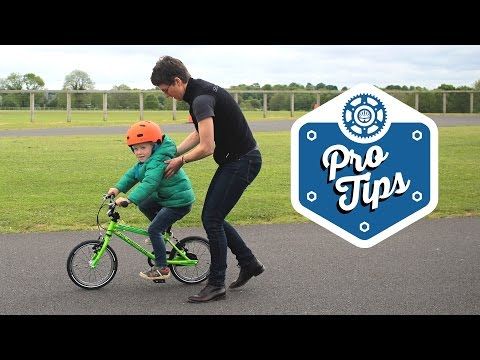 ”
”
1. Is the child ready?
Most children are able to master the skill between three and a half and four and a half years of age. If they're not ready, it's usually obvious by the fact that they won't be able to pedal fast enough to move. nine0003
When children see others riding a bike, they get an idea of how to push on the pedals. Remember, a child has an innate ability to learn to walk and run, but not to pedal. If the time has not come yet, you should be patient and wait.
2. Choose a suitable site
It is important to choose a good site for your first session. It may be tempting to start on grass for a softer fall, but the surface is more viscous and requires more effort to move. nine0003
What you really need is a soft and flat rubberized surface made from a material that is used to cover playgrounds and sports fields. It will allow the child to feel the dynamics of movement. It is ideal to have a large free space so that the child can turn and ride around without thinking about obstacles. Naturally, the place should be away from the movement of cars and pedestrians.
Naturally, the place should be away from the movement of cars and pedestrians.
3. Set up the bike
You bought the right size bike, didn't you? You should not start with a big bike bought "for growth". Set the height of the saddle so that sitting on it, the child reaches the toes of the foot to the ground. There will be a desire to simplify the task and lower the saddle so that you can put your foot on the ground completely. But this position makes pedaling more difficult, the knees rise too high during the ride, interfere with steering and balance.
4. Support the child in his first attempts
It may seem right to hold the bike by the handlebars and saddle, but it gets in the way of understanding how the bike leans and responds to the weight of the rider.
It will be better to stand behind, hold the rear wheel between your legs at the beginning, and support the child by the armpits while moving. So he will fully control the bike, and you will not directly affect the management and will be able to pick it up when you fall.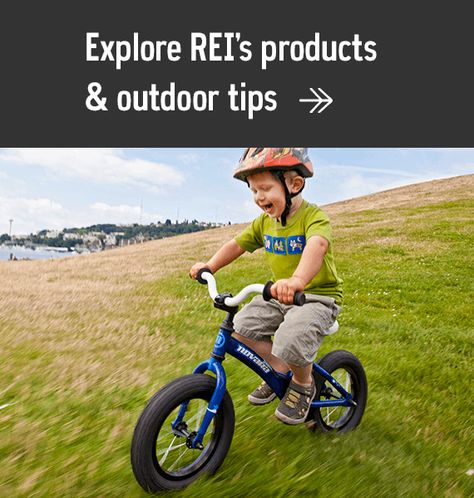 And your back will feel better too.
And your back will feel better too.
5. Gradually release (but be ready to catch)
When the child feels more confident, you can gradually let go, but be ready to catch the armpits if necessary.
When you run after him, you can guide his body and help him understand how the bike reacts to lean, how to turn and turn.
When kids are ready to learn how to ride a bike, they will be able to balance and pedal fast enough to move on their own, usually in one half hour session. nine0003
6. Unassisted
Once balance and pedaling are mastered, you can show how to start moving on your own.
Move the pedal on the side of your stronger foot to the two o'clock position and have your child put their foot on the pedal. Explain that you need to strongly press the foot on the pedal and at the same time slightly push off with the other foot from the ground. It will take a few tries before he grabs it.
7. Learning to slow down
It's easier to introduce the child to the principle of the brakes when he is not in the saddle - ask him to drive the bike nearby, apply the brakes and see what happens. At first, children press the handles sharply and strongly. Tell me that you need to press more smoothly.
At first, children press the handles sharply and strongly. Tell me that you need to press more smoothly.
Once this is learned, get on the bike and give it a few tries. Usually children quickly learn how to brake properly, but they may forget to stick out their foot - be ready to catch!
Gradually the child will be able to ride without your presence. nine0003
8. Try again
It takes practice to master a skill. But remember that every child is different and the moment when he is ready to ride a bike is different.
Be careful not to allow the child to have a traumatic experience. No matter how much you want him to join your trips. With any luck, he'll love practicing his new skill and the freedom it brings.
Yes! And don't forget about protection! This is especially important early on; a helmet is required, and cycling gloves will help to avoid torn palms. Long pants and long-sleeve shirts are preferable to bare elbows and knees and will protect against minor abrasions.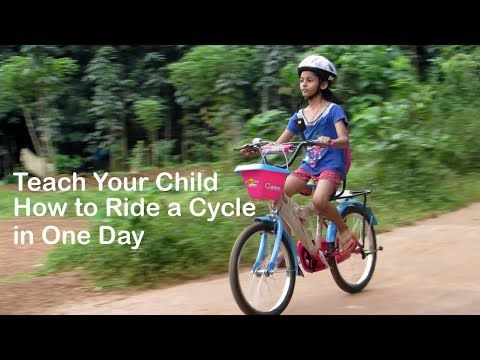 Boots or sneakers are better than sandals. nine0003
Boots or sneakers are better than sandals. nine0003
...
Perhaps you will also find useful our articles "How to assemble a children's bike out of the box" and "How to make it easier for a child's bike"
A short video from the Kazan school of a balance bike:
How to teach a child to ride a bike? Let's help!
The bicycle was and remains the main attribute of a happy childhood. For parents, the process of teaching a child to ride a two-wheeled bike is as natural and inevitable as learning to read, tie shoelaces, etc. It is a proven fact that at an early age it is much easier for a baby to master the skills of cycling. Therefore, parents should not waste time: the sooner the child sits on the "two-wheeled friend", the more happy hours his childhood will be filled with. We will tell you about the basic principles of learning to ride the first children's bike. nine0003
Balance bike - independent riding from two years old
It is better not to transfer a child to a full-fledged two-wheeled bicycle right away. Previously, for most children, the first acquaintance with bicycle technology began with three-wheeled vehicles. Now the modern market offers more effective alternatives in this matter. We are talking about balance bikes - training bikes without pedals, on which you can safely transfer your baby when he reaches 2 years old.
Previously, for most children, the first acquaintance with bicycle technology began with three-wheeled vehicles. Now the modern market offers more effective alternatives in this matter. We are talking about balance bikes - training bikes without pedals, on which you can safely transfer your baby when he reaches 2 years old.
In general terms, a balance bike is not much different from a regular children's bike: it has a metal frame, wheels, a handlebar and a saddle. The main feature is the absence of pedals, and they accelerate on such bicycles - pushing off the ground with their feet. Gaining speed and bending your legs, you can ride a balance bike like a full-fledged bicycle, already at the age of two or three, you can easily overtake your parents on a walk. nine0003
The running bike is not just fun, but a multifunctional trainer. Riding on it, the child perfects the skills of maintaining balance, learns to coordinate movements and independently manage. The stability of the feet on the ground gives the baby confidence in riding: he has good speed control and is not afraid to fall.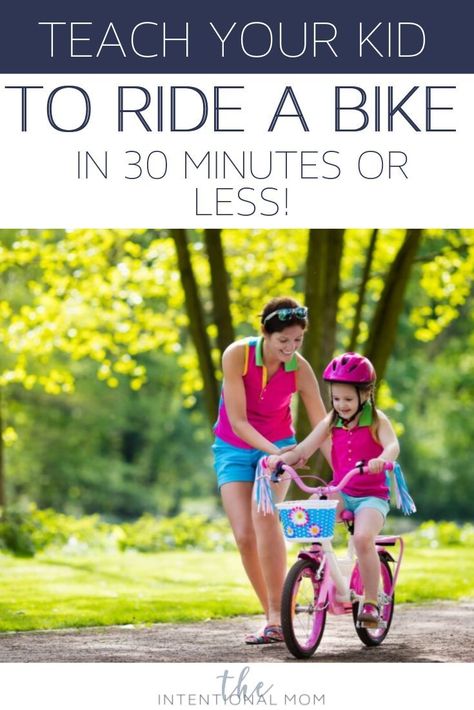 After running a balance bike, already at 3.5-4 years old, children change to pedal bikes and ride confidently without safety wheels.
After running a balance bike, already at 3.5-4 years old, children change to pedal bikes and ride confidently without safety wheels.
What do orthopedists say?
Starting from the age of 2-2.5 years, orthopedists recommend increasing the motor activity of the legs. Since at this age the child is not yet adapted to full-fledged walks, a great alternative for creating symmetrical loads is pedaling (in this case, a tricycle) or riding a balance bike. The latter is more practical in these matters, since the child is guaranteed to ride on his own, and not move with the help of parents pushing the handle of a tricycle. nine0003
Wheelchairs and plastic motorcycles, which are becoming more and more popular among children under 2.5 years old, should be abandoned in favor of a small cross-country bike. It will provide a correct (not so wide) fit, which will result in higher comfort and eliminate the risk of possible orthopedic problems. Unlike another popular vehicle - a scooter - a balance bike provides a symmetrical load on both legs, which eliminates the possibility of uneven muscle development.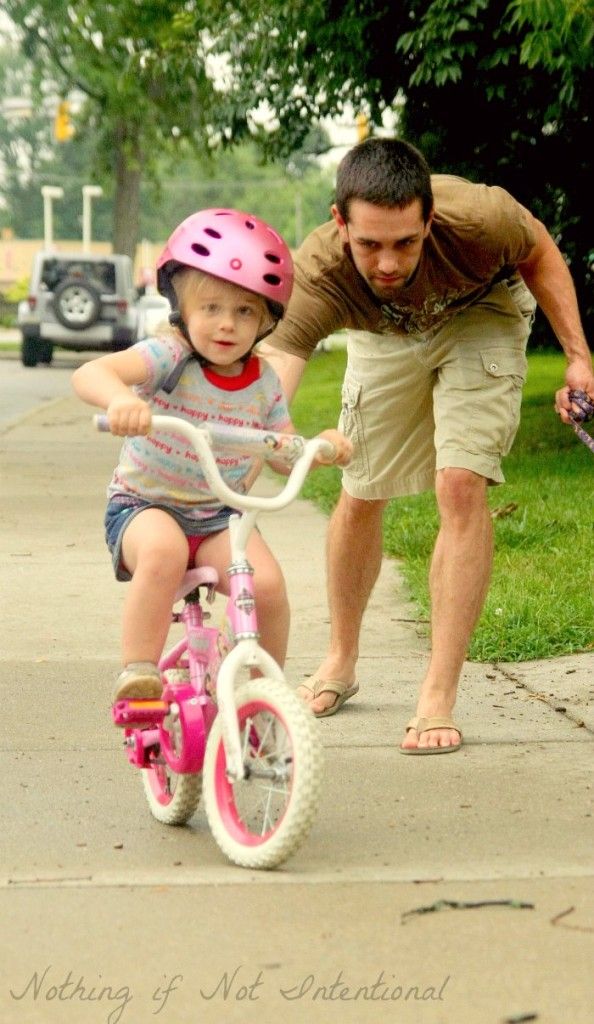 nine0003
nine0003
How to instill a child's interest in a balance bike?
Let's start with the fact that in the vast majority of cases this is not necessary. A new way of moving, speed and independence from parental control - this is all that children happily gravitate towards as early as 2-3 years old. However, adults should remember that if the baby does not have the desire to master new transport, acting by force in this case is not the best option. Persistent actions of parents can form psychological blocks in the mind of the child, and it is possible that in the future he will not show interest in any bicycles. In this case, it is worth acting more subtly and competently. nine0003
Before the age of 5, children learn most skills through imitation. If in your yard there is a child confidently dissecting on a balance bike, do not doubt that your child in absentia will begin to show interest in this transport and want the same. Older brothers and sisters can be of great help in this matter.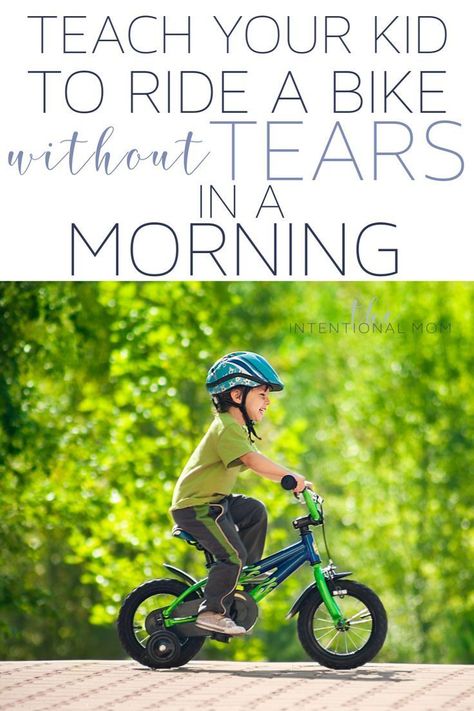 Even a few exciting videos watched together with the child will do their job, and he will definitely show interest in this two-wheeled vehicle.
Even a few exciting videos watched together with the child will do their job, and he will definitely show interest in this two-wheeled vehicle.
Take your balance bike with you on every outing, even though you may have to carry it in your hands at first. Be sure to praise the baby for independent skating, as an encouragement, let's go down from small slides. nine0003
A win-win option to get a child interested in cycling is parental permission to ride in a small puddle. With the smallest, you can play a game by pushing a ball with a wheel or knocking down pyramids of pebbles. Get out more often in parks and other places where there are many peers.
Choosing the first bike with pedals
After the age of 4, the child is ready to switch to a full bike with pedals. If before that he had a balance bike, the process of learning to ride independently will be a formality. For those kids who have not dealt with two-wheeled vehicles, this will take some time. nine0003
As a first bike, 16" wheels are the best choice.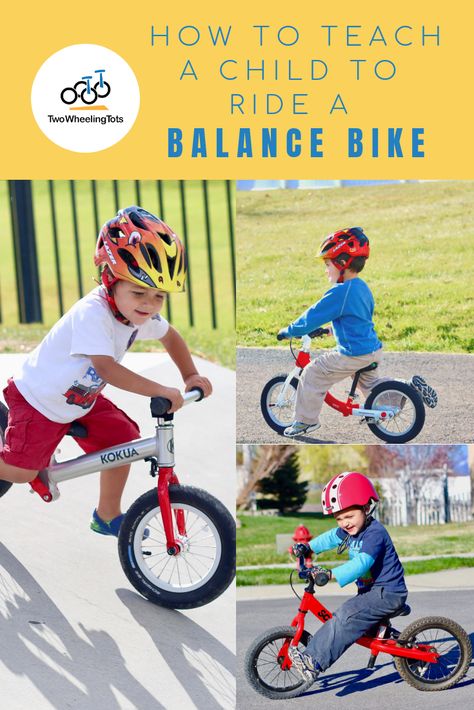 Give preference to models with a minimum configuration: one speed, a foot brake, a protective cover on the chain, safety wheels - this is all that a child needs on the first bike. Pay attention to the fact that the bike has a wide handlebar: if it falls, it will work as a side protection. Hand brakes, panniers, racks, metal fenders, all of these and other elements are not important for the smallest cyclists, they will only make the bike heavier and increase the likelihood of breakdowns. On models with 16-inch wheels, the child will be able to ride up to 7-8 years. nine0003
Give preference to models with a minimum configuration: one speed, a foot brake, a protective cover on the chain, safety wheels - this is all that a child needs on the first bike. Pay attention to the fact that the bike has a wide handlebar: if it falls, it will work as a side protection. Hand brakes, panniers, racks, metal fenders, all of these and other elements are not important for the smallest cyclists, they will only make the bike heavier and increase the likelihood of breakdowns. On models with 16-inch wheels, the child will be able to ride up to 7-8 years. nine0003
Teaching your child to ride a pedal bike
The simplest and safest learning strategy is to use an extra pair of safety wheels. In this case, the child will study longer, but is guaranteed to be safe from falls and will feel more confident. Safety wheels must be installed in such a way that they do not come into contact with the ground. When stationary, the bike should tilt slightly to one side, this will allow the child to better feel the principles of maintaining balance and learn to ride independently faster.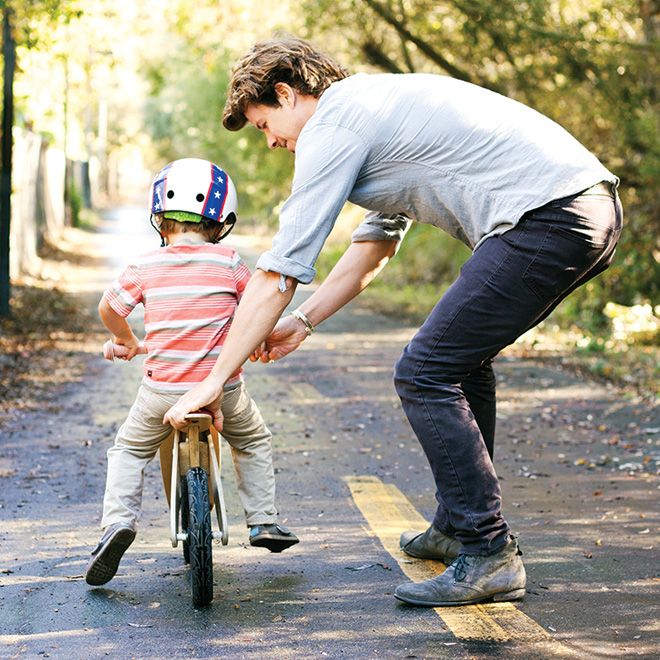 Before riding the first meters, the child must learn to confidently get on and off the new bike. nine0003
Before riding the first meters, the child must learn to confidently get on and off the new bike. nine0003
Set the saddle as low as possible so that the child can reach the ground with both feet. This will give him confidence and he will not be afraid to fall. At first, use the bike as a balance bike. Some even specifically unscrew the pedals so that it is more convenient for the child to push off the ground with their feet. As the baby begins to feel the control of the bike, you can raise the saddle and learn to ride by pedaling.
It is important to explain to your child that you should always look directly at the road, and not at the front wheel or under your feet. Keeping your head straight makes it much easier to keep your balance, and the road itself is perceived as safer, because it is surveyed in advance with all its obstacles. nine0003
Many things that are intuitively clear to adults are not so obvious to a child. Do not forget to explain to your child that the only way to keep balance on a bicycle is to move. A common children's mistake when learning a bike is slow pedaling and slowing down. The more uncertain and slower the child will drive, the longer the learning process will take.
A common children's mistake when learning a bike is slow pedaling and slowing down. The more uncertain and slower the child will drive, the longer the learning process will take.
At first, parents should hold the child even if the bicycle has safety wheels. This is more needed in order to give the baby psychological confidence from parental support. If you are learning to ride without extra wheels, never hold your bike by the seat. This will only complicate the learning process, because. the child will not be able to intuitively feel the principles of maintaining balance. You need to insure the baby by holding him by the shoulder or clothes. nine0003
Learn to ride on flat, straight sections with a minimum of people and other obstacles. As you master your skills, complicate the trajectories of movement: add turns first with a large, and then with a small radius. Do not forget to explain to the child that maneuvering depends not only on one rudder, but it is important to work, including with the body, slightly tilting the body in the direction of the turn.



